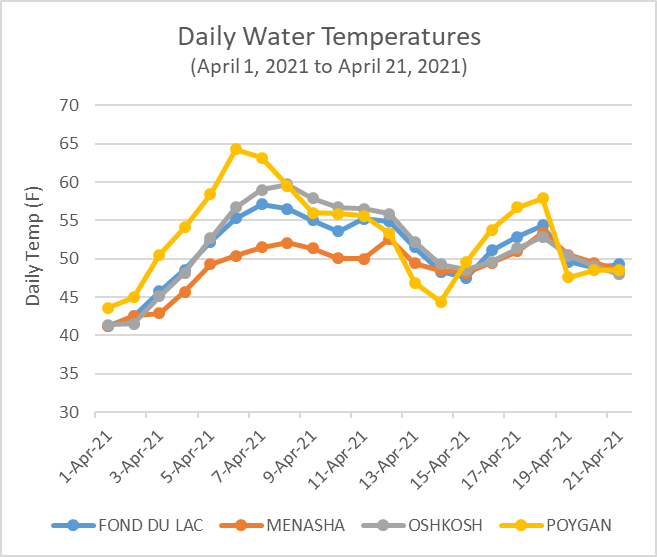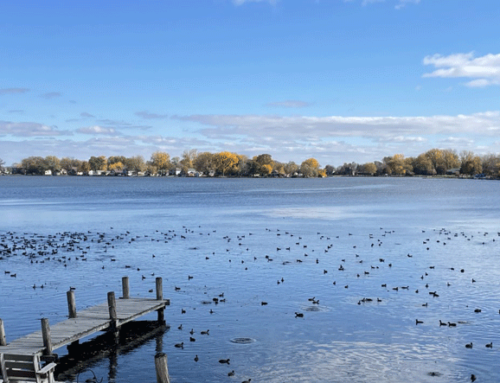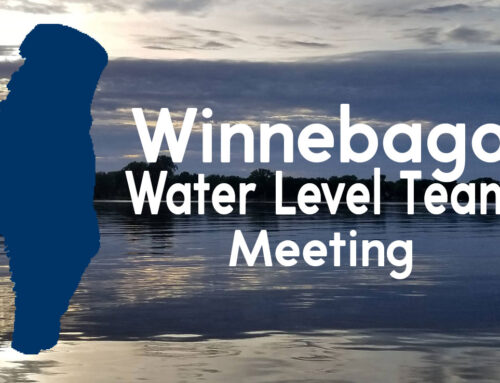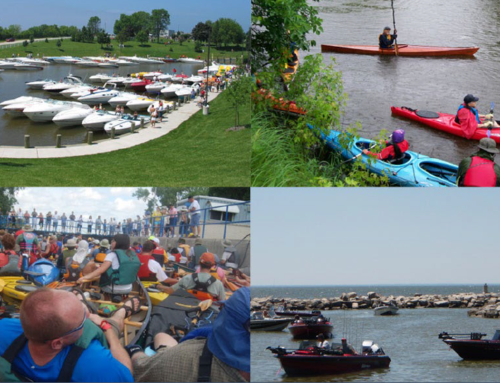The Army Corps of Engineers held their 2021 Spring Refill Meeting on Thursday, April 15th under the open pavilion at Jefferson Park in Menasha. During the meeting, the Army Corps provided an overview of their mission: Flood Risk Management. Here is some background information they shared in a handout:
- The Marshall Order was established in 1886 to “maintain the level of Lake Winnebago at or below” flood stage, and above the crest of the dam which retains that pool.
- The term “flood” is to be considered to refer to all stages of water above an ordinary high‐water stage.
- The 3.5 ft. upper limit specified is 21.25 inches above the spillway crest of Menasha Dam. This was determined by the mean annual high‐water stage for the 28‐year period from 1859 to 1886.
- Today, The Army Corps operates to keep the level within the limits set by the Marshall Order.
As the Army Corp works to meet their mission of flood risk management, they also try to meet the needs of other stakeholders within their operating range. This requires finding a reasonable balance among competing interests. The annual regulation strategy represents that balance and can be broken down by certain times of the year: fall drawdown, winter pool, spring refill, and summer pool. Water level targets are set along this strategy in a schedule. These targets are listed in the Army Corps 2020 – 2021 Lake Winnebago Regulation Strategy (shown in the image below).
Lake Winnebago is currently in the spring refill phase of the annual strategy.
This is shown in the graph featured at the top of this article (CLICK HERE for the live version). Average water level on Lake Winnebago as of April 22nd, 2021 was 2.31 ft. (above the Oshkosh datum) and the gage on Lake Poygan was reading 2.70 ft. Comparing those readings (available on the Army Corps website), the lake is on schedule to meet the following refill targets:
- May 1st – 2.5 ft (Operating band: 2.4 to 3.6 ft)
- June 1st – 2.8 ft (Operating band: 2.7 to 3.9 ft)
- June 15th – 2.9 ft (Operating band: 2.8 to 3.0 ft)
Daily Water Temperature

A gradual rise, like what we are seeing this year, allows aquatic plants along the edges of the lake to have access to the sunlight they need to photosynthesize. Once the plants emerge and begin to grow taller, the tops of the plants will continue to have access to enough sunlight in the water column in the shallower areas of the lakes even as the lake gets deeper and reach summer navigation target.
How is this related to water quality?
Plants help to anchor nutrient rich sediments and use phosphorus. More plants mean less phosphorus would be available for algae during the plant growth season. As a result, more plants could mean fewer or less severe algae blooms and better water clarity.
Average Water Level and Gage Locations
Water levels listed above are an average of four gages located around Lake Winnebago. More information about gages and the elevation of the water’s surface is provided in document the Army Corps handed out at their 2021 Spring Refill meeting (CLICK HERE).
DID YOU KNOW?
Hydroelectric production on the Lower Fox River accounts for around 33% of electricity used in the Fox Valley. Lack of flow in the Lower Fox River can lead to higher energy rates and/or blackouts. Large fluctuations in flow on the Lower Fox River reduce the efficiency of hydroelectric production (as well as lead to flooding and environmental damage on the Lower River). So, even when water levels are lower on Lake Winnebago, it is critical that the Army Corps maintain a certain outflow from Lake Winnebago to the Lower Fox. (Source: ACOE)
Additional links to helpful water level related information:
1.) Water Level Management for the Winnebago Waterways: This report describes water level management including the process of developing an annual strategy, the considerations for the strategy, and the reason the strategy (schedule) is in its current form. CLICK HERE for the report.
Please note: after the report was written, the Army Corps when through redistricting. Management of Lake Winnebago water levels transitioned from the Detroit District to the Chicago District. This has not yet been updated in the report linked here.
This report is part of a larger planning effort for the Winnebago Lakes. The rest of the lake plan can be found here: https://fwwa.org/lake-management-planning-2/
2.) Winnebago Water Level Assessment Team (WWLAT): This is a stakeholder group that holds discussions about water levels independent of the Army Corps public input process. The website for the Team provides information about the background, past recommendations, and more. Interested stakeholders are welcome to participate.
Link: https://fwwa.org/winnebago-waterways/wwlat/
Contact: Korin Doering, Winnebago Waterways Program Director, (920) 851-0948 or korin@fwwa.org
3.) Army Corps of Engineers Lake Winnebago Webpage: The Army Corps provides access to a lot of data and information through their Lake Winnebago webpage: CLICK HERE
Here is a summary of some of the helpful information that can be found at the Army Corps website:
- Lake Winnebago Regulation Strategy 2020-2021: the water level regulation schedule for this year. The schedule starts on October 1st and runs to September 30th each year.
- Current Conditions: a weekly update that is published each Friday with a description of conditions as well as an updated graph. You’ll notice that the graph provided in the weekly update from April 9th shows water levels are on the rise. Note: the water levels shown in that graph represent an average of the four gages located around Lake Winnebago. Local conditions at a given site may vary.
- Lake Winnebago Levels and Flows
- NOAA River Links: interactive maps that indicate flood stage for various rivers
- Observations: flood stage indicators based on measurements taken from gages location on the rivers/streams
- Forecasts: NOAA’s predictions for river stage and potential for flooding
- Levels and Flows: links in this section provide hourly and daily lake levels and flows for the gages (see attached image) the Army Corps uses to inform their management decisions for the dams.
- Lake stage (water level): Lake Winnebago’s stage (water level) is taken as the average of the levels at gages located in Oshkosh, Stockbridge, Menasha and Fond du Lac. Lake Poygan has one gage that is used near the mouth of the Wolf River. There is a newer gage on Lake Butte des Morts that is not yet online because it is unable at the moment to connect to the satellites used to transmit data. Linking the gage to the satellite is in progress.
- Tributary Inflows to Lake Winnebago: inflows to Lake Winnebago from the Upper Fox and Wolf River Basins are estimated using measurements from a network of stream gages. Gages are located in New London, Berlin, Waupaca, and Royalton.
- Inflows at Oshkosh: Inflows to Lake Winnebago are measured using data collected from a gage located in the Fox River in Oshkosh.
- Outflows: outflows from Lake Winnebago are estimated using measurements taken from a gage located in the Fox River in Appleton.
- Historical Data (Experimental): this is one of my favorite resources on the Army Corps webpage because I am very much a visual person. These links provide graphical representation of the data listed in the tables under Levels and Flows. If you look at the top graph with the lake gages, you can see the storm surge and seiche effects over the past couple of weeks. When Fond du Lac is high and Menasha is low, that tells us that the wind was pushing water from the north to the south end of the lake. Then we see the “sloshing” effect after a big wind push as the lake sloshes back and forth trying to level back out.
- NOAA River Links: interactive maps that indicate flood stage for various rivers
- Basin Precipitation
- Various links to precipitation, weather, and snow depth data. Snow depths are important for determining winter drawdown depth and timing.
- Basin Water Temperature
- Links to water temperature recordings. Water temperature is important because it helps provide insight to ice conditions on the water, indicates the likelihood of frazzle ice forming on the Lower Fox River, and certain water temperatures trigger various life cycle processes in our aquatic flora and fauna. For example, many of our native aquatic plants begin to emerge around 55 degrees Fahrenheit.








